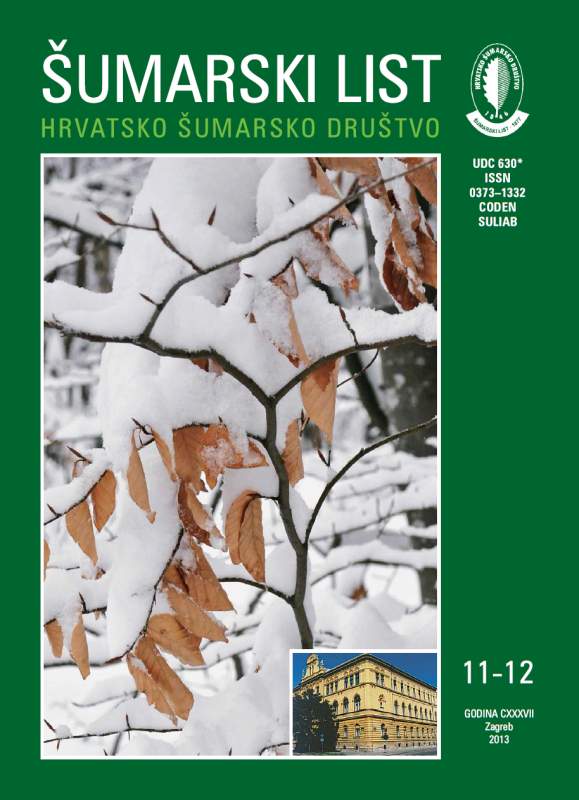
broj: 11-12/2013
pdf (4,23 MB) |
|
||||||||||||||
| RIJEČ UREDNIŠTVA | ||
| uredništvo | ||
| AT THE END OF THE YEAR pdf HR EN | 565 | |
| IZVORNI ZNANSTVENI ČLANCI | ||
| Ivan Perković, Nikola Pernar, Darko Bakšić | UDK 630*114.1 (001) | |
| COMPARISON OF TWO SIEVING AND SEDIMENTATION METHODS FOR DETERMINATION OF PARTICLE SIZE DISTRIBUTION – POSSIBILITIES AND LIMITATIONS OF INTERPRETATION pdf HR EN | 567 | |
| Tarik TREŠTIĆ, Osman MUJEZINOVIĆ, Azra ČABARAVDIĆ, Ismir MURATAGIĆ | UDK 630*412 (001) | |
| IMPACT OF MICRO-LOCALITY FACTORS TO THE INTENSITY OF INFESTATION OF SILVER FIR TREES WITH WHITE MISTLETOE pdf HR EN | 575 | |
| Roman ROSAVEC, Zoran ŠIKIĆ, Željko ŠPANJOL, Damir BARČIĆ | UDK 630*431 + 111 (001) | |
| INFLUENCE OF METEOROLOGICAL PARAMETERS ON FLAMMABILITY OF SOME MEDITERRANEAN SPECIES pdf HR EN | 583 | |
| Matthias KROPF, Gerald HÖLZLER, Rosemarie PARZ-GOLLNER | UDK 630 * 152 + 135 (Castor fiber L.) (001) | |
| GENETIC EVIDENCE ON THE ORIGIN OF THE CURRENT BEAVER (Castor fiber) POPULATION IN LOWER AUSTRIA pdf HR EN | 591 | |
| Andreas Redin, Göran Sjöberg | UDK 630*151 (001) | |
| EFFECTS OF BEAVER DAMS ON INVERTEBRATE DRIFT IN FOREST STREAMS pdf HR EN | 597 | |
| STRUČNI ČLANCI | ||
| Boris Vrbek | UDK 630 *114.4 | |
| THE PREPARATION METHOD OF FOREST SOIL MONOLITHS WITH THE USE OF EPOXY RESIN pdf HR EN | 609 | |
| Summary In the Croatian Forestry Institute a collection of monoliths of the most important forest soils was produced during the period from 2011 to 2013. The collection was made by means of a new method of attachment and preparation with the use of epoxy resin. After digging the pedological pit, the profile is prepared and a prism of soil, measuring 20 cm x 100 cm and 5 cm thick, is made. With a sharp tool it is then separated from the soil and placed horizontally so that the monolith can be analysed and fixed onto the base. In the case of skeletal soils we gradually move the soil from the marked prism in the pedological profile into the frame according to marked parts. After drying the monolith is fixed with clear matte varnish, following which it can be presented in a vertical position or on the wall of an exhibition area. The new method is less complicated and faster because it does not require a massive monolith in a large box, which is occasionally difficult to transport to the first communication road. Key words: Soil Monolith; pedology; epoxy resin. Collection of works | ||


